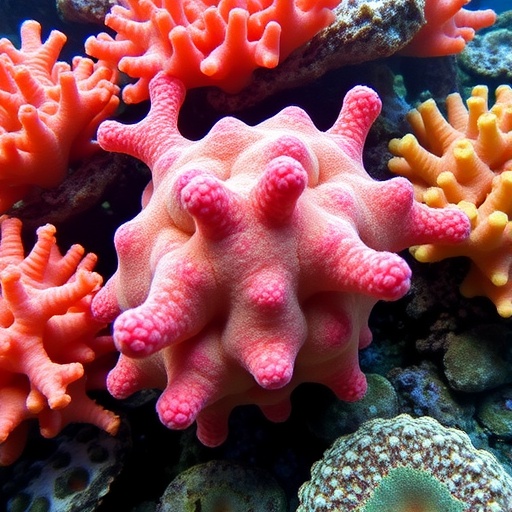QUT researchers have made significant strides in understanding the biological mechanisms that enable corals to attach to reef surfaces—a finding pivotal for enhancing global coral restoration efforts. The study, published in Royal Society Open Science, is led by Dr. Brett Lewis of the Queensland University of Technology (QUT) and examines the attachment dynamics of three coral species: Montipora mollis, Pocillopora verrucosa, and Acropora millepora. As coral reefs face unprecedented declines due to climate change and environmental pressures, these insights could transform approaches to coral restoration strategies worldwide.
For a long time, the complexities of how corals manage to reattach to the reef have baffled marine biologists. Despite extensive research over decades, understanding the precise sequence of events that enable coral fragments to establish themselves on a reef surface has remained elusive. Dr. Lewis, alongside a dedicated research team—including renowned experts like Professor Peter Prentis and Associate Professor Luke Nothdurft—set out to unveil this mystery. Their research aims to deepen our grasp of the attachment process, enabling a more nuanced approach to the challenges of coral rehabilitation.
Using state-of-the-art microscopy technologies, the team uncovered a sophisticated, three-step attachment process that coral fragments undergo when reconnecting with the reef. Initially, upon making contact, the coral tissues react through an immune response, signifying the start of the attachment journey. This reactive phase almost resembles a biological mechanism where the coral ‘flips’ its tissues internally to prepare for the next stage. Understanding this immune response could lead to significant applications in enhancing coral resilience.
Following the initial immune response, corals proceed to anchor themselves by developing new soft tissue that securely binds them to the reef. This vital step is integral to establishing a foothold and marks the beginning of the fragment’s transformation into a self-sustaining coral organism. The survival of coral fragments largely hinges on the success of this soft tissue anchor. The implications for coral restoration efforts are profound, as this knowledge can guide selection processes for more resilient coral fragments capable of thriving in varied conditions.
The final phase of the attachment process is where the coral mechanics come into play. During this stage, corals build their skeletons, which are typically formed inside the coral body, onto the substrate of the reef. This process is facilitated by a specialized appendage that interacts with the reef’s surface—growing the skeletal structure while simultaneously working to eliminate pathogens and competing organisms. This insight could lead to innovative strategies for accelerating coral growth in restoration projects.
Dr. Lewis and his team discovered notable differences in attachment efficiencies among the three coral species studied. For example, Montipora mollis exhibited a larger and more complex appendage, which resulted in faster and stronger attachment to the reef. Conversely, Pocillopora verrucosa displayed a thinner, more fragile appendage that developed more slowly, potentially explaining its weaker attachment capabilities. The implications of these findings highlight the need for tailored restoration approaches that consider these biological variances among species.
Interestingly, the research brought to light the crucial role of mesenterial filaments—dramatically overlooked thread-like structures within the coral’s anatomy. These filaments not only assist in the initial attachment by digesting unnecessary tissues but may also play a critical role in coral recovery during stressful environmental conditions. This suggests that these structures may contribute to the overall health and resilience of corals, particularly during periods of stress or environmental disruption.
This groundbreaking research promises to revolutionize coral restoration methodologies that have traditionally adopted a one-size-fits-all framework. With these new insights, scientists and conservationists can refine their strategies by selecting specific coral species that are more likely to thrive in particular ecological conditions. By applying this targeted approach, the effectiveness and efficiency of coral restoration efforts can be significantly enhanced, potentially leading to more successful outcomes in the fight to save these vital ecosystems.
As awareness of coral reef decline grows among policymakers and the public, findings from this study strengthen the urgency to invest in coral restoration initiatives that are informed by scientific research. The role of marine scientists is paramount in educating communities about the importance of these ecosystems, not just for biodiversity but for the health of marine environments. Understanding the biological intricacies of coral attachment is just one element in the multi-faceted approach needed to restore and protect our oceans.
Overall, the collaborative efforts of the QUT research team, together with the backing of programs such as the Australian Government’s Research Training Program and the Reef Restoration and Adaptation Program, underscore the importance of multidisciplinary approaches in tackling environmental challenges. As global coral populations continue to struggle, unlocking the mechanisms of coral attachment offers a glimmer of hope that can lead to actionable solutions aimed at preserving these crucial marine habitats.
In summary, the findings from Dr. Lewis’s team emphasize that while the basic processes of attachment are conserved among coral species, the specific biological characteristics can significantly influence outcomes. The diversity in attachment mechanisms can inform which coral species are best suited for various reef conditions and restoration efforts. This research lays the groundwork for future studies that can further unravel coral biology, potentially guiding conservation strategies in an era where climate change poses a severe threat to marine ecosystems.
We stand at a crossroads for coral reefs; understanding how they thrive and can be assisted in their growth and recovery is crucial. This research not only sheds light on the biological processes of coral attachment but also opens avenues for developing innovative restoration techniques that can be tailored based on species-specific needs. It is an essential step in our ongoing battle to ensure the longevity of coral reefs globally.
Subject of Research:
Coral fragment attachment mechanisms.
Article Title:
Asexual reproduction in reef-building corals: insights into fragment attachment to improve restoration and predict natural recovery.
News Publication Date:
29-Oct-2025.
Web References:
Link to the article
References:
No additional references provided.
Image Credits:
Credit: QUT
Keywords
Coral reefs, reef-building corals, marine biology, asexual reproduction, coral attachment processes.




